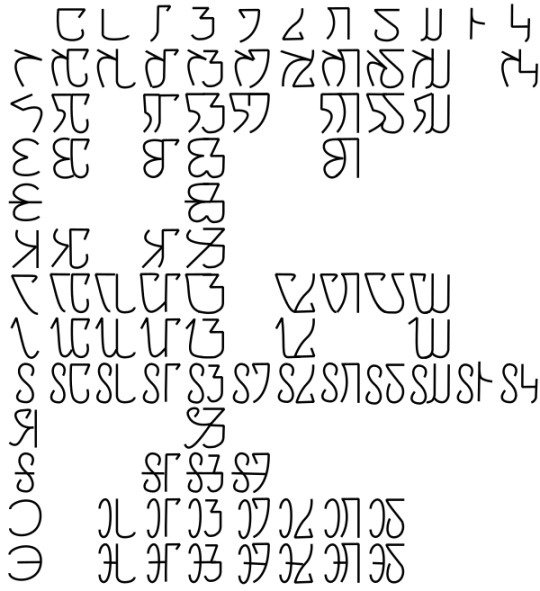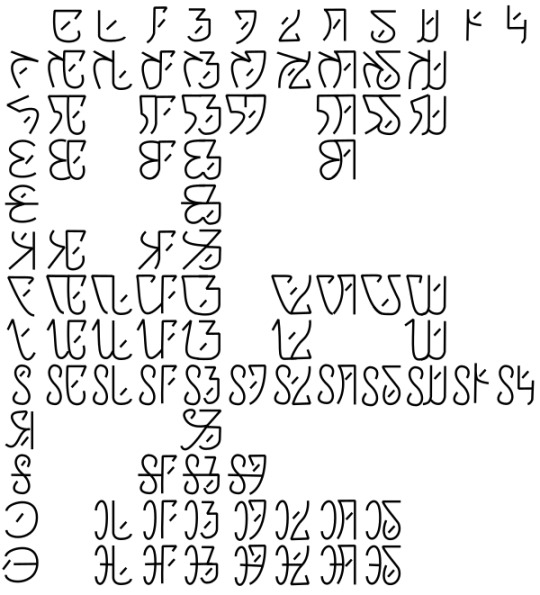#and diphthongs are written as horizontal pairs squished together to fit in one space
Explore tagged Tumblr posts
Text
After uniting the Hamaran-speaking states in western Altuum, the prince Ghwailan engaged in a program of prestige-building that included promoting the Hamaran language and literature; to that end, he brought to his court Khnimor ja Damras, the renowned polymath, and charged him with creating a native orthography for the Hamaran tongue, to replace the clumsily adapted southern letters that were until then used in the (rare) production of Hamaran-language documents.
Khnimor set about the task with enthusiasm; he tried first a logographic system (as most aspiring lettersmiths do); finding it clumsy, he then tried a syllabic system, then an alphabetic one. He was determined to create for Ghwailan a system of surpassing usefulness and elegance, and he was something of a perfectionist. Eventually, he decided that he needed to embark on a program of study to understand the nature of sounds in language at the most basic level. He spent years studying phonetics, comparing the orthographies of various languages, and producing and discarding one system of writing after another.
Finally, at the end of this project, he produced what are called now the Khnimoran Lettters. They were an attempt to create a writing system capable of phonemically representing every language in the world, or at least every language Khnimor knew of. Individual symbols, which were clearly distinguishable but quick to write, could be composed together to indicate place and manner of articulation, voice, and other features; and by the study of basic elements, one could learn to represent hundreds of unique sounds.
Unfortunately, the result was not especially useful for Hamaran, and Ghwailan had become incredibly irritatd with Khnimor's perfectionism; he charged a different court official with implementing a basic spelling reform, and Khnimor's letters were never used in Hamara, or anywhere else in his lifetime. The linguists of the south rediscovered the letters a generation or two later, however, and found them an excellent basis for a phonemic orthography, for use in the study of languages; over time, they became the scholarly standard in Nebressa, Sayyedhu, and many other places for phonemic representation of languages, and the basis for more elaborate systems of phonetic representation.
In respect to the International Phonetic Alphabet, the Khnimoran Letters have some deficincies. They cannot represent some very fine phonetic details: they do not indicate relative features like "less rounded" or "more rounded;" they do not distinguish different kinds of release, or syllabicity; linguolabial sounds cannot be represented, and taps, flaps, and trills are all written with the same symbols. Some of these limits are down to the more limited aspirations of Khnimor, who was not trying to create as detailed a phonetic scheme of representation as the International Phonetic Association of our own world; others, due to limits in languages known to him and to later scholars--clicks and implosivs were known to Khnimor, but not complex tone systems.
The core symbols of the Letters are meant to be easily recognizable and quick to write. The consonants are abstract, being largely unrelated to their meaning; the vowels, however, are loosely based on a representation of where they are in the perceptual vowel space, represented as a two-dimensional grid. The primary features represented are place of articulation (bilabial, labiodental, dental, alveolar, postalveolar, retroflex, palatal, velar, uvular, pharyngeal, and glottal) and manner of articulation (plosive stop, implosive stop, click, lateral click, ejective stop, nasal, tap/trill, fricative, ejective fricative, lateral fricative, approximant, and lateral approximant). A place or manner symbol can stand on its own for any sound of that class. Additional marks can distinguish voicing (unvoiced, voiced, breathy voiced, creaky voiced), or features like labialization or palatalization.
The current standard of the Khnimoran Phonemic Alphabet (as it is now called) is maintained by the University of Presh, lightly altered and slightly extended. The main KPA chart shows the base symbols and ligatures for regularly encountered combinations; marginal or impossible groupings are omitted. The version shown here adds the specifically voiced forms of the consonants to show where the voicing diacritic is usually positioned, and the vowels in both their short and long forms. Rounded vowels are marked using the labialization sign.
Khnimoran Letters (consonants)


Khnimoran Letters (vowels)

The most commonly encountered diacritics, shown below, are labialization, palatalization, velarization, and pharyngealization (shown above the main character); aspiration and nasalization (shown below), and additional voicing marks (here, creaky, breathy, and unvoiced).

#sogant raha#conlanging#i forgot to include this in the main description#but affricates and double articulations are written vertically on top of each other#and diphthongs are written as horizontal pairs squished together to fit in one space
20 notes
·
View notes